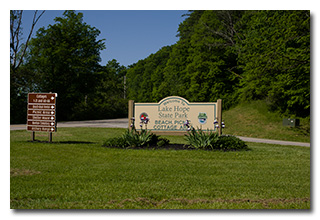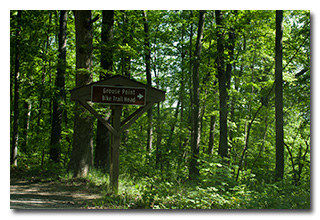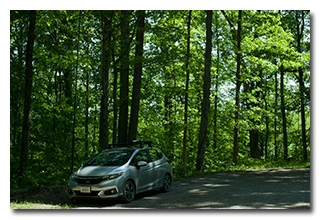
by William Eric McFadden
From the Lake Hope State Park website:
-
Lake Hope State Park offers a truly relaxing, yet rustic getaway from the high speed of modern life. The entire park lies within the Zaleski State Forest in the valley of Big Sandy Run. The park's heavily forested region is marked by steep gorges and narrow ridges with remnants of abandoned mining and iron-producing industries.
The park surrounds the lake and boasts a wooded family campground and a variety of cabins for families and gatherings of all sizes, including the roomy Laurel Lodge. No visit to the park is complete without a stop in the dining lodge for a hearty meal.
From the Zaleski State Forest website:
-
The 27,822-acre Zaleski State Forest is the second largest forest in Ohio's system of state forests.
Zaleski State Forest operates the only state-owned sawmill in Ohio. The mill produces rough sawn lumber for use by Ohio’s state forests and state parks as well as other government agencies.
Historic Moonville Tunnel is located within Zaleski State Forest on the Moonville Rail Trail right-of-way.
Pictures
Description
 On Sunday, May 23, 2021, one member of the Southeast Ohio Radio Adventure Team
performed a successful two-fer activation of Lake Hope State Park and Zaleski State Forest in Ohio as part of the Parks on the Air (POTA; link)
program. Eric McFadden, WD8RIF, performed the impromptu two-fer activation at the Grouse Point Trailhead area of Lake Hope State Park
within Zaleski State Forest. This was Eric's first visit to Lake Hope State Park or Zaleski State Forest since determining that
the pair qualified for two-fer activations. Eric was accompanied by the two small dogs, Theo and Mindy.
On Sunday, May 23, 2021, one member of the Southeast Ohio Radio Adventure Team
performed a successful two-fer activation of Lake Hope State Park and Zaleski State Forest in Ohio as part of the Parks on the Air (POTA; link)
program. Eric McFadden, WD8RIF, performed the impromptu two-fer activation at the Grouse Point Trailhead area of Lake Hope State Park
within Zaleski State Forest. This was Eric's first visit to Lake Hope State Park or Zaleski State Forest since determining that
the pair qualified for two-fer activations. Eric was accompanied by the two small dogs, Theo and Mindy.
Eric arrived at the unoccupied Grouse Point Trailhead in Lake Hope State Park at 1400 UTC, parked the car, and quickly deployed his 28½' wire vertical on his Jackite 31' telescoping fiberglass mast and drive-on mount. Because he had forgotten to place his folding camp-chairs in the car, Eric set up his KX3 inside his car and was on the air at 1415 UTC.
 Eric was surprised to discover that despite his smartphone showing no signal-bars he had sufficient cell-signal to both text and
access the POTA Spots website. Eric was able to self-spot himself on POTA Spots and to look for park-to-park (P2P) QSO opportunities.
Eric was surprised to discover that despite his smartphone showing no signal-bars he had sufficient cell-signal to both text and
access the POTA Spots website. Eric was able to self-spot himself on POTA Spots and to look for park-to-park (P2P) QSO opportunities.
Eric began operations by checking POTA Spots for possible park-to-park (P2P) QSOs and at 1418 UTC he made a P2P QSO on 40m with NA9M who was activating Waunakee Marsh State Wildlife Area (K-4339) in Wisconsin.
Finding himself a frequency on 40m, Eric made ten QSOs in twenty minutes. This run included a P2P QSO with K0BWR who was activating Platte Falls State Conservation Area (K-5710) in Missouri and a P2P QSO with W8MSC who was activating Island Lake State Recreation Area (K-3315) in Michigan.
 Pausing to check POTA Spots for P2P opportunities, at 1444 UTC Eric made a P2P QSO on 30m with NG5E who was activating Lake Tawakoni
State Park (K-3031) in Texas and at 1449 UTC he made a P2P QSO on 30m with VE2WFF who was activating Long Point Ecological Reserve
(VE-2452) in Manitoba, Canada.
Pausing to check POTA Spots for P2P opportunities, at 1444 UTC Eric made a P2P QSO on 30m with NG5E who was activating Lake Tawakoni
State Park (K-3031) in Texas and at 1449 UTC he made a P2P QSO on 30m with VE2WFF who was activating Long Point Ecological Reserve
(VE-2452) in Manitoba, Canada.
Finding his own frequency on 30m, Eric made a final three QSOs in seven minutes. This short included a P2P QSO with K0BWR who was still at Platte Falls State Conservation Area (K-5710) in Missouri.
In all, Eric made sixteen QSOs including six P2P QSOs in about forty minutes. All of Eric's QSOs were CW and were made at the 5-watt level.
Eric also submitted his log to the World Wide Flora and Fauna in Amateur Radio (WWFF; link) program for Lake Hope State Park, KFF-1968.
(return)